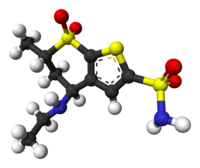Dorzolamide
 |
|
 |
|
| Clinical data | |
|---|---|
| Trade names | Trusopt |
| AHFS/Drugs.com | Monograph |
| MedlinePlus | a602022 |
| Pregnancy category |
|
| Routes of administration |
Topical (eye drops) |
| ATC code | |
| Legal status | |
| Legal status |
|
| Pharmacokinetic data | |
| Protein binding | ~33% |
| Biological half-life | 4 months |
| Identifiers | |
|
|
| CAS Number | |
| PubChem CID | |
| IUPHAR/BPS | |
| DrugBank | |
| ChemSpider | |
| UNII | |
| KEGG | |
| ChEBI | |
| ChEMBL | |
| Chemical and physical data | |
| Formula | C10H16N2O4S3 |
| Molar mass | 324.443 g/mol |
| 3D model (Jmol) | |
|
|
|
|
|
|
|
Dorzolamide (trade name Trusopt) is a carbonic anhydrase inhibitor. It is an anti-glaucoma agent, and acts by decreasing the production of aqueous humour. It is administered as a topical ophthalmic in the form of a 2% solution.
This drug, developed by Merck, was the first drug in human therapy (market introduction 1995) which resulted from structure-based drug design. It was developed to circumvent the systemic side effects of acetazolamide which has to be taken orally.
Dorzolamide hydrochloride is used to lower increased intraocular pressure in open-angle glaucoma and ocular hypertension.
It lowers IOP by about 20%.
Ocular stinging, burning, itching and bitter taste. It causes shallowing of the anterior chamber and leads to transient myopia.
...
Wikipedia
